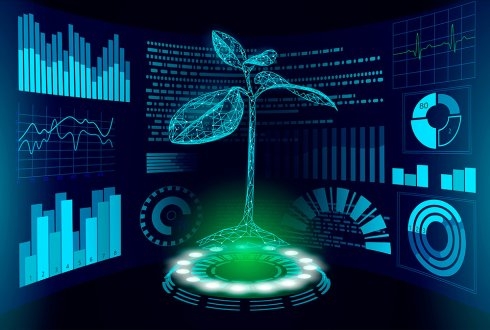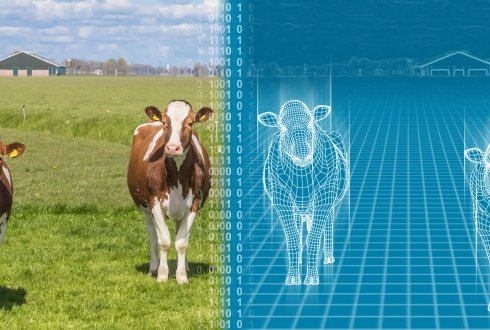Today, more and more companies are using digital twins of physical devices, which evolve over time thanks to data collected by sensors, for example to measure the level of wear and tear on machine parts and prevent them from wearing out or breaking down. "This technology was initially used only on extremely critical devices for aeronautics or space exploration. But it is now being used by larger companies to monitor the operational condition of equipment that costs only a few tens of thousands of euros, such as silos, pallet transporters and even boilers," explains Vincent Champain, General manager of the Digital Foundry for General Electric Digital.
Researchers at the University of Wageningen (WUR) announced at the beginning of the year their intention to work on digital twins in the areas of tomatoes, food and farming. The projects are called "Virtual Tomato Crops; Me, my Diet and I", and "Digital Future Farm". They explained that digital twins, one of the three investment themes of the WUR Strategic Plan 2019-2022, represent a relatively new concept in the field of agronomy, consisting of computer models of individual objects or processes that are updated on the basis of real-time information.
WUR has searched for digital twin projects that can achieve major scientific and social breakthroughs in Wageningen's areas of expertise. Collaboration is a high priority for this investment program, notably because knowledge from different disciplines is essential for a successful digital twin to function.
 Three subjects were chosen for groups of researchers from very diverse disciplines to work on during the coming three years. Around EUR 1.2 million per project has been made available by WUR.
Three subjects were chosen for groups of researchers from very diverse disciplines to work on during the coming three years. Around EUR 1.2 million per project has been made available by WUR.
Virtual tomato crops
Jochem Evers and his team are developing a digital twin of a tomato crop in a greenhouse: a 3D simulation model that is fed in real-time with sensor information from a real greenhouse. These constant updates make this digital twin more advanced than the existing simulation models. Interactions between crop characteristics (variety), environmental factors and crop management are all simulated in the virtual crop. Because the model is linked to a real tomato crop in a greenhouse, it becomes possible to constantly refine predictions and thus make better choices for the real crop.
According to the main project leader Jochem Evers, "We chose the tomato because we already know so much about this crop; we have a lot of experience with measuring and 3D modeling of tomatoes, as well as with various cultivation techniques. When developing the digital twin, we incorporate the ideas of a user group of people interested from the start of the project. They know what is going on in tomato cultivation and what we should focus on in the model."
Evers hopes to have a properly working prototype in three years. Growers will be able to use it as a decision-support tool for growing tomatoes. The tool can also be used to determine strategies: one can make adjustments to the greenhouse settings in the model, and then carry out the most promising strategies on the real crop.
 "Growers will be able to use it as a decision-support tool for growing tomatoes. For example, it will allow them to predict the effect of a cultivation measure on harvest and financial yield and make a decision for the real crop based on that prediction."
"Growers will be able to use it as a decision-support tool for growing tomatoes. For example, it will allow them to predict the effect of a cultivation measure on harvest and financial yield and make a decision for the real crop based on that prediction."Evers talks about the benefits for research: "Researchers no longer have to do repeated tests to be able to make reliable statements, and you immediately know what the result of changes in, for example, greenhouse settings or pruning or varieties, will be. That way we can also conduct targeted research into new varieties, finding out, for example, which qualities a variety should have to do well given any restrictions in energy consumption or in a certain type of greenhouse."
Evers himself is a theoretical plant biologist, but his team is very diverse: employees of the (new) Netherlands Plant Eco-phenotyping Center (NPEC) on the campus, as well as WUR researchers in the fields of greenhouse horticulture, economics, agrotechnology, statistics and breeding. "That collaboration was already interesting in the start-up phase and the project hadn’t even begun."
Digital twins and IoT
This technology should not be confused with the Internet of Things. "With IoT, we suck data from a physical object and its environment thanks to sensors, but with digital twins, we inject data into a virtual object, which we can then cause to evolve as it goes through the aging process. But it is true that without sensors, digital twins cannot exist. So this technology does depend on the IoT," explains Vincent Champain.
A digital twin (or device shadow) is a digital replica of an object, a process or a system that can be used for various purposes. Digital representation provides both the features and the operating dynamics of an IoT device throughout its life cycle.
Digital twins integrate artificial intelligence, machine learning and data analysis to create digital simulation models that update and change as their physical counterparts evolve. A digital twin is constantly learning and updating itself using multiple sources to represent its status, its working conditions or its position almost in real time. This learning system is autonomous in its learning process thanks to various sources:
• sensor data that transmits various aspects of its operating conditions;
• human experts, such as engineers with in-depth and relevant knowledge of the field of application;
• other individuals or similar systems in the fields of industry, biology, analytics, etc.;
• larger systems and components of the environment of which it is a part.
A digital twin also utilizes historical data from the past use of the machine, which it integrates into its digital model.
 In various industrial sectors, digital twins are used to optimize the operation and maintenance of physical devices, systems and manufacturing processes. Digital twins represent a form of training technology for the industrial Internet of Things, where physical objects can exist and interact virtually with other machines and people. Researchers will now be exploring the capacity of biological systems to accommodate this type of technology and the opportunities that these new applications can provide for progress in the field of agronomy.
In various industrial sectors, digital twins are used to optimize the operation and maintenance of physical devices, systems and manufacturing processes. Digital twins represent a form of training technology for the industrial Internet of Things, where physical objects can exist and interact virtually with other machines and people. Researchers will now be exploring the capacity of biological systems to accommodate this type of technology and the opportunities that these new applications can provide for progress in the field of agronomy.
Some complementary data
For further details and contacts relating to these projects, see:
Source: wur.nl, hortidaily.com, journaldunet.com



 "Growers will be able to use it as a decision-support tool for growing tomatoes. For example, it will allow them to predict the effect of a cultivation measure on harvest and financial yield and make a decision for the real crop based on that prediction."
"Growers will be able to use it as a decision-support tool for growing tomatoes. For example, it will allow them to predict the effect of a cultivation measure on harvest and financial yield and make a decision for the real crop based on that prediction." In various industrial sectors, digital twins are used to optimize the operation and maintenance of physical devices, systems and manufacturing processes. Digital twins represent a form of training technology for the industrial Internet of Things, where physical objects can exist and interact virtually with other machines and people. Researchers will now be exploring the capacity of biological systems to accommodate this type of technology and the opportunities that these new applications can provide for progress in the field of agronomy.
In various industrial sectors, digital twins are used to optimize the operation and maintenance of physical devices, systems and manufacturing processes. Digital twins represent a form of training technology for the industrial Internet of Things, where physical objects can exist and interact virtually with other machines and people. Researchers will now be exploring the capacity of biological systems to accommodate this type of technology and the opportunities that these new applications can provide for progress in the field of agronomy.


























